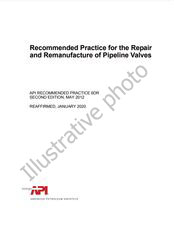We need your consent to use the individual data so that you can see information about your interests, among other things. Click "OK" to give your consent.

API PUBL 4731-ed.2003
Light Non-Aqueous Phase Liquid (LNAPL) Parameters Database - Version 2.0 - User Guide
Translate name
STANDARD published on 1.12.2003
The information about the standard:
Designation standards: API PUBL 4731-ed.2003
Publication date standards: 1.12.2003
SKU: NS-1139881
The number of pages: 90
Approximate weight : 301 g (0.66 lbs)
Country: American technical standard
Category: Technical standards API
Annotation of standard text API PUBL 4731-ed.2003 :
API PUBL 4731, 2003 Edition, December 2003 - Light Non-Aqueous Phase Liquid (LNAPL) Parameters Database - Version 2.0 - User Guide
PREFACE: The Light Non-aqueous Phase Liquid (LNAPL) Parameters Database is a collection of information about samples that have had their capillary parameters determined, as well as other physical parameters measured. Capillary properties are critical in multiphase calculations, and those results have very high sensitivity to these properties. The primary purpose of this database is to provide information to users who are trying to characterize the movement and distribution of LNAPL within a site that has a limited set of direct observations of the capillary properties of the site. Other databases of related parameters have typically been derived from measurements in the agricultural or the petroleum extraction industries; neither being necessarily representative of near-surface environmental conditions. This database give the user the opportunity to understand the range of capillary characteristics observed at sites that are geologically similar, but where there are more direct and laboratory observations available.
This document is broken up into 4 primary sections: Data Retrieval, Data Entry, Database Design, and Database Maintenance. Most users have interest in the first topic.
• The Data Retrieval section describes the types of data that are contained in the database and how a user can quickly retrieve subsets of the database that match various user input filters or selection criteria. This section includes several user scenarios with user inputs and database outputs conveyed through a series of sample screens and text.
• The Data Entry section describes how a user can add new data to the database using two primary data entry methods: 1) manual data entry through data entry forms, and 2) data import from electronic sources. Both methods are described and examples are provided. API recommends that only individuals and organizations with a high level of technical and database expertise attempt to add data to the database.
• Appendices A-C are written for database developers. A detailed description of the database design is provided in the first appendix. This section describes the structure of the database and the relationships between its tables, queries, forms, reports, and macros. The database maintenance section describes areas within the database that will require periodic maintenance and how to perform that maintenance, data validation, removing data from the database, etc.
We recommend:
Technical standards updating
Do you want to make sure you use only the valid technical standards?
We can offer you a solution which will provide you a monthly overview concerning the updating of standards which you use.
Would you like to know more? Look at this page.



 Cookies
Cookies
